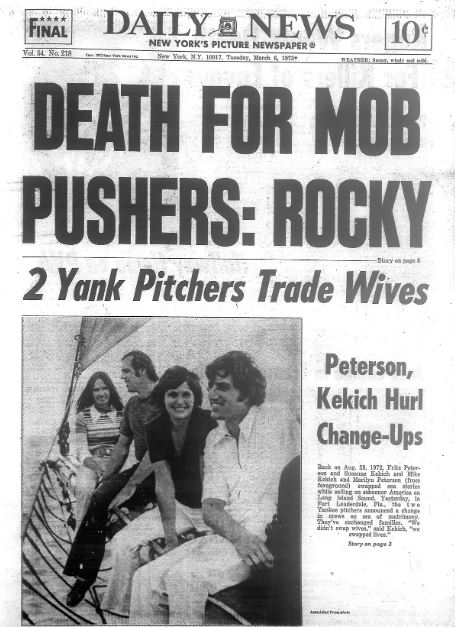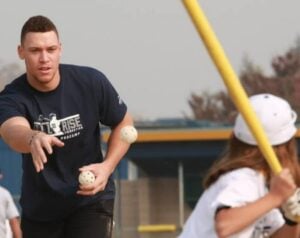Top 10 most weird moments in Yankees lore


Inna Zeyger
More Stories By Inna Zeyger
- Mother’s Day: How Anthony Volpe’s mom molded him into a Yankee phenom
- Aaron Judge on verge of joining elite Yankees club, finds inspiration in Winfield, Jeter, CC
- Steinbrenner ‘got ears’ to hear Yankees’ challenges, yet no gurantee of change
- Michael Kay’s show heading to December ending amid uncertainty over ESPN deal
- Yankees’ Gleyber Torres projected to sign with NL West contender
Table of Contents
The New York Yankees, a name inseparable from baseball royalty, boast 27 World Series rings that gleam like a king’s crown. However, beyond the pinstriped facade of championships and legendary players, lies a concealed treasure trove—a compilation of peculiar, bizarre, and completely unforgettable moments that inject a bit of zest into the Yankees legacy.
So, set aside the highlight reels and accompany us on an exploration through the less-traveled corridors of Yankees history. Here, ostrich-eating outfielders, wife-swapping pitchers, and airborne baseballs intertwine to create a tapestry of the absurd.
When a Yankees player outdueled an ostrich
Envision this: Jacksonville, Florida, April 3rd, 1919. The air is thick with spring training fever, and at the epicenter of the Yankees camp, an unusual duel is set to unfold. In one corner stands Ping Bodie, a charismatic outfielder with a competitive spirit matching his speed. In the other corner looms Percy, a nine-foot-tall ostrich celebrated as one of the world’s top eaters. The challenge? Spaghetti supremacy, orchestrated as part of a whimsical publicity stunt by Yankees co-owner T.L. Huston.
Unfortunately, no cameras documented this peculiar clash of titans. Yet, legend recounts a gallant skirmish, with Bodie devouring platefuls of pasta with the finesse of a seasoned gourmand, while Percy, despite his formidable reputation, faltered after a mere eleven servings. The nimble Yankees star, it appeared, had met his match in the ostrich.
Fast forward to the present day, and baseball enthusiasts can’t help but ponder: What if Hal Steinbrenner, the Yankees owner in the 21st century, embraced the spirit of 1919? Picture Aaron Judge, the brawny slugger, engaged in a noodle-slurping showdown with a contemporary Percy. Or envision CC Sabathia, renowned for both his appetite and fastball, taking on a pasta-piling challenge. The scenarios are boundless and potentially uproarious.
Certainly, the dynamics of the game have evolved. Present-day spring training publicity stunts might lean more towards drone flyovers and virtual reality batting demonstrations. Nevertheless, wouldn’t it be delightful to witness a return to the era of ostrich-eating heroes and spaghetti-fueled rivalries? It serves as a gentle reminder that amid the pursuit of pennants and playoffs, there’s always room for a touch of lighthearted absurdity in the realm of baseball. Thus, while we may never witness Judge indulging in a pasta face-off against an emu, the tale of Bodie and Percy stands as a delectable testament that, at times, the most unforgettable moments in baseball are the ones that are simply peculiar.
When a Yankees pitcher took on more than just the Giants
On October 2nd, 1936, at the Polo Grounds, the Bronx Bombers were dominating their crosstown rivals, the Giants, with a 9-0 lead in Game 2 of the World Series. The atmosphere crackled with tension, and anticipation hung thick in the air. In the fourth inning, as the formidable Mel Ott prepared to bat, Lefty Gomez, a pitcher renowned for his fiery spirit and quick wit, did something unexpected. He halted the game, diverting his gaze from the batter to something high above the diamond.
In the vast New York sky, an airplane glided, a silver speck against the azure canvas. Gomez, momentarily captivated, embraced a childlike wonder, his eyes wide with awe. This, to the chagrin of manager Joe McCarthy, who urged his star pitcher to refocus.
Yet, Gomez, ever the showman, had a purpose. This majestic spectacle, a machine conquering the heavens, mirrored the Yankees’ dominance on the field. They were soaring, invincible, masters of their realm. It was this sense of wonder, this connection to something greater than the game, that fueled Gomez’s passion.
Returning to the mound, a renewed fervor burning in his eyes, he shut down the Giants, securing a complete-game victory in the 18-4 rout. The Yankees went on to clinch the World Series in six games, solidifying their dynasty and adding another chapter to their storied legacy.
Lefty Gomez‘s upward glance might appear as a whimsical moment, a fleeting distraction in the midst of a championship battle. However, it transcended that. It symbolized the indomitable spirit of the Yankees, their ability to discover inspiration in the unexpected, and their unwavering belief in their own greatness. As long as they kept their eyes on the sky, reaching for something beyond the diamond, the Bronx Bombers knew they could achieve anything.
Therefore, the next time a plane glides above Yankee Stadium, don’t dismiss it as a passing sight. Recall Lefty Gomez, the stargazing ace, and let it serve as a reminder: sometimes, the greatest triumphs emerge not only from grit and determination but also from a moment of wonder, a glance at the sky that reiterates what it genuinely means to soar.
When wit, wisdom, and baseball collide
No exploration of the eccentric world of Yankees lore would be comprehensive without a visit to the Yogi-ism emporium. Although the late and great Yogi Berra once playfully remarked, “I didn’t really say all the things I said,” there’s no denying that he was an abundant source of quotable gold.
From the timeless wisdom encapsulated in “It ain’t over ’til it’s over” to the perplexingly brilliant “It’s like déjà vu all over again,” Yogi gifted the world a collection of malapropisms and paradoxes that, somehow, miraculously made perfect sense on the baseball diamond.
His greatness extended beyond his playing days. As a coach and manager, Yogi continued to deliver one-liners, presenting us with treasures like:
- “The future ain’t what it used to be.” A poignant reflection on the ever-evolving landscape of the game.
- “Nobody goes there anymore; it’s too crowded.” A Yogi-esque take on the paradox of popularity.
- “You can observe a lot just by watching.” A seemingly simple statement containing layers of wisdom.
- “When you come to a fork in the road, take it.” Unconventional advice that, coming from Yogi, carries its own unique wisdom.
- “Baseball is 90 percent mental. The other half is physical.” A profound perspective on the blend of athleticism and strategy that defines baseball’s allure.
Yogi-isms weren’t merely humorous; they were philosophical gems hiding in plain sight, encapsulating the essence of baseball and life itself with a wink and a grin. They served as reminders that sometimes, the most profound truths are packaged in unexpected forms, and that laughter and wisdom can coexist in the most delightful ways.
So, the next time you overhear a player mutter, “It’s déjà vu all over again,” don’t dismiss it. Recall Yogi, the bard of the Bronx Bombers, and his unique talent for transforming baseball into a stage for clever reflections and unexpected insights. Although he may be gone, his words linger like spirits at Yankee Stadium, resonating through the stands and prompting us to embrace the Yogi-isms, letting the absurdity of the game wash over us.
When Yankees players swapped wives

St. Petersburg, Florida, March 4th, 1973. The spring training sunlight bathed Yankee Stadium in brilliance, but the real heat emanated from an impromptu press conference that would go down in Major League Baseball history as unprecedented. Two Yankees pitchers, Mike Kekich and Fritz Peterson, stood side-by-side, unveiling a decision that was simultaneously shocking and oddly charming: they were engaging in a swap of wives, families, and even dogs for the upcoming season.
Before you gasp in disbelief, it’s essential to remember that this was the spirited, freewheeling era of the Swinging Seventies. Experimentation wafted through the air, and these families, friends since 1969, were eager to ride the wave. It was, as they clarified, an opportunity to break free from the monotony of baseball life and inject a dose of unpredictability.
Unfortunately, the experiment was short-lived. The connection between Kekich and Marilyn Peterson faded away quicker than a popup foul, while Fritz Peterson and Susan Kekich discovered a spark that ignited a marriage lasting for decades. Today, they remain happily together, a testament to life’s unexpected twists, even in the heart of spring training.
In hindsight, the wife-swapping episode remains a peculiar footnote in baseball history, serving as a reminder that at times, the off-field lives of athletes can be as dramatic and unpredictable as anything occurring on the diamond. It’s a tale that reflects the spirit of free expression during that era, the close-knit bonds of baseball families, and the unexpected turns of fate leading to surprising happily-ever-afters.
So, the next time you encounter a peculiar baseball trade story, recall the saga of Kekich and Peterson. It’s a narrative that underscores the idea that sometimes, the most captivating transactions unfold not at the trade deadline, but amidst the sun-drenched fields of spring training, where even the most unconventional experiments can yield unexpected victories, both on and off the field.
When a gift mooed its way into Yankees lore
On August 4th, 1985, Yankee Stadium pulsed with bittersweet energy as it hosted Phil Rizzuto Day, a heartfelt tribute to the cherished shortstop whose number 10 would forever grace Monument Park. In a nod to Rizzuto’s iconic broadcasting catchphrase, “Holy Cow!”, a whimsically ingenious plan emerged from the Yankees front office: presenting him with an actual cow, complete with a cardboard halo.
Imagine the spectacle: a radiant black bovine adorned with angel wings strolling onto the field, guided by a handler. Rizzuto, moved by the gesture, radiated joy. Yet, this was no trained performer. The cow exhibited a mind of its own or, perhaps, a disdain for cardboard halos. In a comical twist, it deviated from its course and, with a gentle nudge, sent Rizzuto tumbling onto the soft grass behind home plate.
The crowd gasped, followed by eruptions of laughter. Even Rizzuto, momentarily stunned, couldn’t resist a chuckle. It resembled a scene from a slapstick comedy, a moment uniquely crafted by baseball’s blend of tradition and absurdity.
Fortunately, both Rizzuto and the cow emerged unharmed from the encounter. In fact, this unexpected incident evolved into a cherished chapter in Yankees lore, captured in photographs and recounted in anecdotes. It wasn’t just about the pratfall; it encapsulated the spirit of the occasion, the audacity of placing a cow on a baseball field, and the way everyone, from Rizzuto to the fans, embraced the chaos with good humor.
So, the next time “Holy Cow!” echoes through the air, recall not only the phrase but also the day a genuine cow took center stage at Yankee Stadium. It serves as a reminder that the most unforgettable moments in baseball often arise not from home runs or strikeouts, but from the unpredictable and humorous detours that make the game delightfully human.
When a Yankees player stole snacks of a boy
On September 16th, 1992, as shadows lengthened at Yankee Stadium during a lackluster season matchup against the White Sox, an unforgettable moment unfolded for one young fan. With the Yankees trailing 9-6 in the twilight innings, a foul pop from a White Sox bat sailed toward the first base stands. Don Mattingly, the iconic “Donnie Baseball,” sprang into action, eyes fixed on the wayward ball. However, an enticing aroma emanating from a wide-eyed boy’s open popcorn box in the front row proved distracting.
In a split-second decision destined for baseball lore, Mattingly reached into the boy’s popcorn, deftly scooped a handful with the practiced skill of a first baseman, and nonchalantly enjoyed the golden kernels while completing the defensive play. He returned to his position with a sheepish grin, transforming a routine foul pop into a moment of pure joy.
The crowd’s stunned silence was swiftly replaced by uproarious laughter. Mattingly, known for his playful nature, had turned ordinary play into a magical interaction, sharing a popcorn snack with a young fan. The game may have ended in a loss for the Yankees, but the boy with the popcorn box walked away with a memory etched in baseball history. He witnessed not just a future Hall of Famer, but a relatable human being, a man unafraid to break the mold and share a laugh with an unsuspecting fan. It stood as a testament to the human connection between players and fans, a reminder that the magic of the game extends far beyond the confines of the field and the numbers on scoreboards.
So, the next time a foul ball rattles the seats, recall the day when Donnie Baseball took a bite out of history, sharing a popcorn moment with a fan. It underscores that sometimes, the most memorable plays don’t happen on the field but in the shared laughter and unexpected connections that make baseball truly special.
When a wink almost launched home runs in pinstripes
In the expansive realm of Yankees lore, a unique chapter unfolds not on the diamond but on the screen. It’s 1995, and Seinfeld, the sitcom about nothing, presents a scene that becomes forever entwined with Yankees history. Enter Cosmo Kramer, the mastermind behind nonsensical schemes, and Paul O’Neill, the fiery right fielder renowned for his intensity and, well, not exactly two-homer nights.
In his trademark Kramerian fashion, Kramer encounters a child facing illness. Bursting with empathy and perhaps a touch of delusion, he assures the boy that O’Neill will hit two homers his way, “just like that!” The peculiar exchange reaches O’Neill, who understandably finds it perplexing. “It’s terrible!” he groans. “You don’t hit home runs like that. It’s hard!” (Apparently, someone hasn’t witnessed The Warrior’s laser shots.)
Thus, the stage is set for a cosmic collision of expectation and reality. As the night unfolds, the stadium buzzes with an odd undercurrent—a blend of baseball tension and the weight of Kramer’s audacious pledge. To everyone’s surprise, O’Neill unleashes a powerhouse hit, propelling a rocket toward the centerfield wall. It bounces, it scrambles, it flirts with home run territory… and settles into a dust-cloud triple, labeled an error for good measure.
The two-homer prophecy falls short, but something magical occurs in its place. The near-miss transforms into a shared narrative—a moment where baseball and absurdity merge, where Kramer’s extravagant promise and O’Neill’s almost-home-run craft a memory that surpasses the confines of the scorecard. It serves as a reminder that sometimes, the true delight of the game lies not only in victory but in unexpected moments, shared laughs, and the recognition that life, akin to baseball, can be as unpredictable and humorous as any scenario concocted by Cosmo Kramer.
Hence, the next time a fan shouts “Two homers, O’Neill!”, don’t dismiss it as wishful thinking. Recall the night Kramer brought Hollywood to the Bronx, the night a triple felt like a near-miracle, and the night when we discovered that, occasionally, the most memorable innings in Yankees history unfold not just on the field but in the space between a promise, a swing, and a wink.
When a helmet led to an epic Yankees episode
The 1999 AL Division Series against the Texas Rangers transcended mere baseball; it transformed into a war zone, with one soldier taking a direct hit in Game 1. Don Zimmer, the cherished Yankees bench coach, wasn’t felled by a swing of the bat but rather by a sharp Chuck Knoblauch line drive straight to the head.
The Bronx collectively held its breath. Yet, Zim, the eternal fighter, wasn’t about to be benched by an errant projectile. The very next day, he reappeared in the dugout, not sporting a mere bandage but donning a helmet. And not just any helmet – a gleaming green Army helmet proudly featuring the Yankees’ iconic “NY” logo and Zim’s own battle cry, “ZIM,” painted on the sides.
This headgear was more than a protective measure; it was a statement. Bruised but unbroken, Zim had transformed his wound into a warrior’s crown. In that helmet, he ceased to be merely a coach; he became a symbol of grit, resilience, and the indomitable Yankees swagger. And it worked. The Bronx Bombers roared back, clinching Game 2 and sweeping the Rangers.
The helmet evolved into a rallying symbol, a tangible representation of their coach’s fighting spirit. Throughout the playoffs, Zim proudly wore it, a silent warrior leading his troops to World Series glory. As the victory parade wound through the streets of New York, the green helmet atop Zim’s head gleamed in the autumn sun – a testament to the unexpected heroes who sometimes sport pinstripes instead of armor.
Zim’s helmet story wasn’t merely about a head injury; it epitomized the indomitable spirit of the Yankees. It showcased their ability to turn adversity into strength and their talent for transforming the most improbable things into icons. So, the next time you witness a player overcoming a challenge, recall Zim and his green helmet, serving as a reminder that, at times, the greatest victories are achieved not only on the field but in the hearts and minds of those who adamantly refuse to be knocked down.
When Jeter swapped cleats for comedy
On December 1st, 2001, while the confetti from the Yankees World Series celebration was still settling, Derek Jeter, the Captain himself, stepped onto a different kind of stage: Studio 8H of Saturday Night Live. This wasn’t your typical offseason routine; this was Jeter embracing full Hollywood mode, exchanging pinstripes for punchlines, and proving that even baseball heroes can excel as comedy gods.
The night overflowed with moments that had the audience in fits of laughter. “Derek Jeter‘s Taco Hole” saw Jeter serenading the crowd with his mariachi vocals (perhaps not entirely smooth but undeniably memorable) alongside SNL legends like Will Ferrell and Jimmy Fallon. The crowd erupted in cheers as they witnessed the Captain strumming his guitar, cleverly endorsing a New Jersey eatery in his own unique way.
Yet, the pinnacle of the evening came with “Yankees Wives.” Decked out in wigs and flamboyant dresses, Jeter, David Wells, and David Cone transformed into enthusiastic fans, comically portraying the wives of their fellow Yankees. The image of these baseball giants parading around in high heels and lipstick had the audience doubled over in laughter, revealing that the Yanks possessed some hidden comedic talents beyond the confines of the diamond.
Jeter’s SNL appearance wasn’t just about generating laughs; it was a display of the playful side of a baseball icon, showcasing a facet unafraid to poke fun at himself and his teammates. It served as a reminder that even the most legendary athletes are fundamentally human, possessing a sense of humor and a willingness to unwind.
So, the next time Derek Jeter’s name comes up, don’t solely associate it with clutch hits and World Series trophies. Recall the night he graced Saturday Night Live, swapped a bat for a guitar, and donned a dress for comedic brilliance. It was a performance that left us with sore cheeks and a newfound admiration for the Captain’s versatility, both on and off the field.
When the Yankees embraced Oz
The Yankees boast a rich history of peculiar traditions, and among the pantheon of costume antics, one day outshines the rest like a ruby slipper: September 25th, 2007. This wasn’t merely a routine dress-up day; it marked a full-fledged immersion into the fantastical realm of Oz, a day when the Bronx underwent a magical transformation into Emerald City, and pinstripes collided with poppy fields.
The spark for this whimsical journey? A disheartening 7-6 loss to the Devil Rays. Rather than allowing defeat to cast a gloomy spell, the Yankees chose to turn it into a technicolor triumph. They adorned costumes inspired by the beloved story, bringing the magical land of Oz to vibrant life within the confines of Yankee Stadium.
Joba Chamberlain, with his fiery spirit and a cascade of hair, embraced the role of the Cowardly Lion, discovering courage in a costume as impressive as his fastball. Shelley Duncan, tall and lean like a field of wheat, embodied the Scarecrow, his straw-stuffed attire rustling with every breeze that swept through Yankee Stadium. Phil Hughes, with his mechanical pitching prowess, became the Tin Man, each stride accompanied by the rhythmic clink of his oiled ensemble. And leading the whimsical parade was Ian Kennedy as Dorothy, a reminder that even in the Bronx, there’s no place like home (plate).
Yet, the festivities wouldn’t be complete without a touch of mischief. Kei Igawa, the enigmatic Japanese pitcher, embraced the wings and mischievous grin of a Flying Monkey, injecting a playful chaos into the already fantastical scene.
The day transcended mere costumes and laughter; it epitomized the indomitable Yankees spirit, refusing to let a loss dim their creativity and sense of fun. It served as a poignant reminder that baseball, at its essence, is a game of joy, a realm where even the toughest losses can metamorphose into enchanting moments.
So, the next time you witness a team donning goofy costumes, don’t dismiss it. Recall the day the Yankees followed the yellow brick road, reminding us that sometimes, the most remarkable victories unfold not on the scoreboard, but in the hearts of players and fans who dare to dream in technicolor.
When honesty went viral in pinstripes
On April 7th, 2010, Fenway Park resonated with the customary intensity of a Yankees-Red Sox clash, culminating in the Bombers quelling the Green Monster with a 3-1 triumph. However, the post-game chatter wasn’t dominated by Aaron Judge‘s stellar plays or Gerrit Cole’s pitching mastery; instead, the spotlight focused on Chan Ho Park and his… well, digestive escapades.
Manager Joe Girardi, attributing Park’s absence to illness, had spared him from media obligations. Yet, when tenacious reporters, perhaps fueled by Fenway’s famous baked beans, managed to locate him, they received more candor than anticipated. Park, wearing a bewildered expression that blended confusion with amusement, promptly responded to their inquiry about his health with a straightforward, “I had a lot of diarrhea. Is that what you want to know?”
Laughter erupted in the clubhouse. Joba Chamberlain, renowned for his contagious laughter, doubled over at the unexpected sincerity. Even the composed Mariano Rivera couldn’t resist cracking a smile. Despite Park’s initial surprise at the reaction, he turned to Chamberlain with a bemused, “What, it’s funny? Save it.”
The moment stood as pure baseball gold. In a sport often draped in clichés, Park had delivered a line as honest and unforeseen as a knuckleball. It wasn’t just the subject matter; it was the delivery — the deadpan expression and the shrug of bewilderment that resonated.
Naturally, the internet erupted with enthusiasm. “TMI, Chan Ho!” transformed into a meme, immortalized through gifs and blog posts. Beyond the initial hilarity, Park’s honesty was endearing. In a realm where athletes frequently polish their words and cloak themselves in platitudes, he had opted for unvarnished truth, reminding us that even baseball superstars are, fundamentally, human.
Chan Ho Park’s “diarrhea day” may not occupy a prominent space in Yankees lore besides pennant-clinching homers or World Series triumphs. Nonetheless, it serves as a reminder that some of the most enduring moments are the unexpected ones — those that prompt laughter because they’re refreshingly authentic. So, the next time a player surprises you with an unexpected revelation, don’t merely brush it aside. Recall Chan Ho Park and his forthright honesty, embracing the absurdity and genuine moments that elevate baseball beyond a mere game.
When Aaron Judge asked fans to judge
Ah, the year 2017, a time of innocence before the era of Judgement Day descended upon Major League Baseball. Back then, a slender youngster named Aaron Judge could seamlessly blend into the New York crowd, akin to a pretzel stick in a ballpark nacho bucket. Picture him perched behind a desk in Bryant Park, sporting clear-frame glasses, inconspicuously hidden amidst the swirl of Yankees hats and jerseys. The future pinstriped legend sat amongst them, undetected.
This scenario was part of a Tonight Show prank, masterminded by the playful Jimmy Fallon. Judge, the burgeoning force from the Bronx, engaged unsuspecting New Yorkers in a quiz about the “mystery slugger” dominating headlines. One well-intentioned individual, in his cotton socks, proudly expressed his admiration for “Adam Judge,” oblivious to the fact that the genuine article was mere inches away.
The spectacle is comedy at its finest. Aaron Judge, the man destined to send baseballs into orbit, relegated to the role of a baseball fan quiz show contestant. It serves as a reminder that even the most brilliant stars have humble beginnings, a time before the dazzle of the spotlight, before the thunderous applause of the crowd, before the Judgement Day that forever altered the course of baseball.
Imagine it as Clark Kent blending into the crowd before donning the red cape, or a young Babe Ruth, still in pinstriped short pants, honing his swing in the shadows of Yankee Stadium. The potential simmered beneath the surface, waiting to erupt onto the stage and rewrite the annals of the record books.
So, the next time you witness Judge launching a 450-foot moonshot or hear his name resonate through the Bronx, harken back to this Bryant Park moment. Recollect the era when “Aaron who?” was a legitimate query, a time when the future remained unwritten, and a youthful slugger sat inconspicuously among the fans, dreaming of the pinstriped destiny that awaited him.
When Didi and Ronnie took the dugout by storm
The 2017 Yankees embodied a team ablaze with passion, driven by unforeseen heroes and an infectious sense of enjoyment. At the core of this vibrant Bronx atmosphere was the diminutive powerhouse, Ronald Torreyes. Standing at a modest 5-foot-6, Torreyes endeared himself to fans not only for his gritty performance on the field but also for his off-the-field antics.
His pièce de résistance? The “Toe-Night Show.” Inspired by a dugout tradition from the Cubs earlier that season, Torreyes, armed with makeshift props (a bat, a glove, or even a water bottle), ingeniously transformed himself into a humorous impromptu cameraman. His partner in this endeavor? The suave Didi Gregorius, assuming the role of a charismatic interviewer, grilled his teammates after notable home runs.
The inaugural episode unfolded during a scintillating 6-1 victory over the Orioles, sparked by Starlin Castro’s long-anticipated home run. As Castro circled the bases, Torreyes unveiled his “camera,” capturing the exuberant scene. Back in the dugout, Gregorius, microphone in hand, morphed into “Didi G,” playfully questioning Castro about his moonshot. Laughter erupted in the dugout, and the stands buzzed with delight – thus, the Toe-Night Show was born.
What began as a lighthearted goof quickly blossomed into a Yankees sensation. From Giancarlo Stanton’s colossal blasts to Aaron Judge’s majestic homers, every home run triggered an episode of the Toe-Night Show. Torreyes’s ingenuity with his “camera” props – a helmet, a Gatorade cooler, or even a pizza box – knew no bounds. Gregorius’s wit as “Didi G” left players and fans in stitches. The dugout transformed into a stage, the players became stars, and the Toe-Night Show emerged as the unforeseen entertainment that brought the Bronx community even closer.
Although the 2017 Yankees didn’t clinch the World Series, they left behind a legacy of joy and inventiveness. The Toe-Night Show stands as a living testament to that spirit, serving as a reminder that, amid the high stakes of Major League Baseball, some of the most cherished moments arise from laughter, camaraderie, and a generous dose of Bronx-sized fun.
So, the next time you hear the resounding crack of the bat, let the Toe-Night Show come to mind. Envision Ronnie and Didi, their infectious smiles illuminating the dugout, and the echoes of laughter reverberating off the walls of Yankee Stadium. It’s a gentle nudge that baseball transcends mere statistics and scores; it’s about those unexpected instants, the collective joy, and the enchantment that unfolds when teammates metamorphose into performers, turning the dugout into a stage for the Bronx Broadcast.
What do you think? Leave your comment below.
- Categories: aaron judge, cc sabathia, derek jeter, didi gregorius, don mattingly, fritz peterson, Hal Steinbrenner, joba chamberlain, Lefty Gomez, Mariano Rivera, mike kekich, New York Yankees, paul o'neill, phil rizzuto, Yogi Berra
- Tags: aaron judge, cc sabathia, derek jeter, didi gregorius, don mattingly, fritz peterson, Hal Steinbrenner, joba chamberlain, Lefty Gomez, Mariano Rivera, mike kekich, New York Yankees, paul o'neill, phil rizzuto, Yogi Berra


 Follow Us
Follow Us









